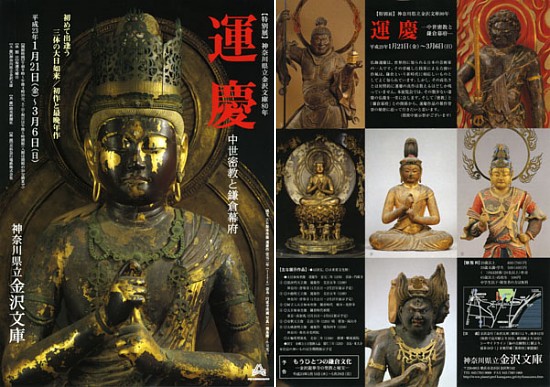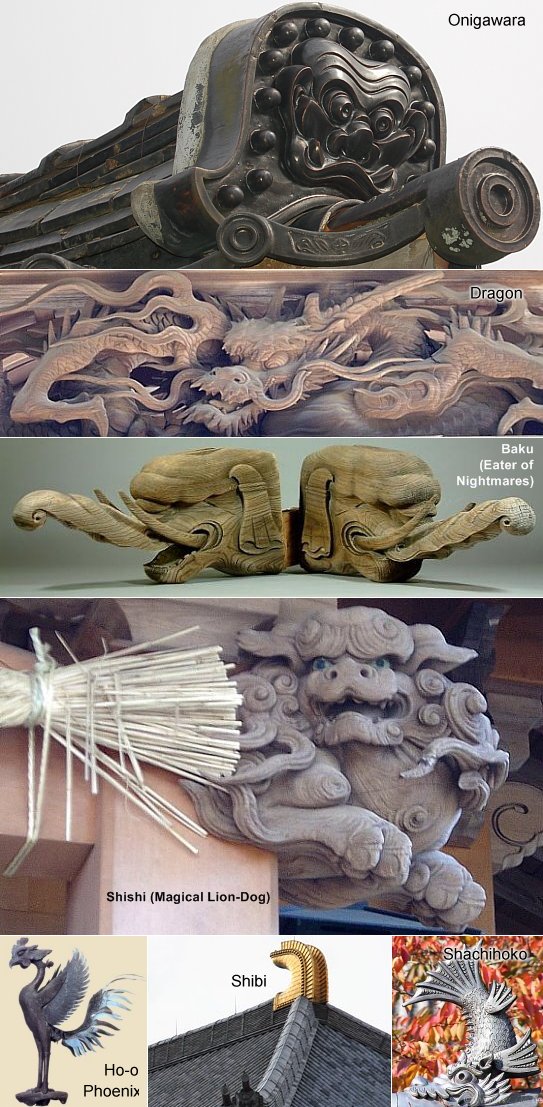Buddha Statues & Japan – Feb. 2011
February 27th, 2011Hello Subscribers,
Knowledge and product updates for February 2011.
Updates to A-to-Z Dictionary of Japanese Deities
» Hikyū 貔貅, Chn. = Pìxiū 貔貅
http://www.onmarkproductions.com/html/hikyu-beast.html
A composite beast of ancient origin, mostly forgotten in Japan, but still popular today in China, Hong Kong, Taiwan, and Singapore. The mythological dragon-headed, lion-bodied Pìxiū 貔貅 (also spelled 豼貅) were traditionally depicted in China as a male-female pair. In ancient China, statues of the two guarded the entrance to the tomb, as they are thought to ward off evil and protect wealth. In one Chinese legend, the male beast somehow angered the Jade Emperor, who punished it by limiting its diet to gold and by sealing its rectum — thereby preventing the animal from defecating. The creature thus came to represent the acquisition and preservation of riches.
» Suijin 水神, Water Kami (Deities) of Japan.
http://www.onmarkproductions.com/html/suijin.html
The term Suijin (literally water kami or water deity) refers to the many heavenly and earthly manifestations of the benevolent Shintō divinity of water. But it also refers to a wide variety of mythological and magical creatures found in lakes, ponds, springs and wells, including serpents (snakes and dragons), eels, fish, turtles, and the flesh-eating Kappa.
» Eight Great Bodhisattva. Hachi Daibosatsu 八大菩薩 or Hachi Bosatsu .
http://www.onmarkproductions.com/html/mandala-deities.html#8GreatBodhisattva
These eight are described in various sutra, wherein their names and attributes differ.
They appear often in the Japanese Womb World Mandala.
Updates to Buddha Statue eStore
» Special Year-End Clearance Sale Continues (33% to 70% Off).
http://www.buddhist-artwork.com/html/special-deals.html
In The News, & Current/Upcoming Exhibitions
» Monk brings global view to Buddhism
http://search.japantimes.co.jp/mail/fl20110219a1.html
After 18 years as head of a Zen monastery in U.S., Issho Fujita now provides help around the world.
» Unkei — Medieval Esoteric Buddhism & the Kamakura Bakufu
Special Exhibition from Jan. 21 through March 6th at the Kanagawa Prefectural Kanazawa Bunko Museum 神奈川県立金沢文庫 in Yokohama. If you live in Japan, don’t miss this exhibition, which features seven carvings by Unkei, one of Japan’s most lauded sculptors from the Kamakura-period (13th century). Learn much more about Unkei at the A-to-Z Dictionary. See our January newsletter for more details and photos of this exhibition.
» Edo Period Paintings from Gitter-Yelen Collection
Shizuoka Prefectural Museum of Art. Runs until March 27.
http://search.japantimes.co.jp/cgi-bin/fa20110218a3.html.
Also make sure to see the Gitter-Yelen web site, which features hundreds of images from Edo-period (1615–1868) works in the Zenga, Nanga, Rinpa, Maruyama-Shijo, Ukiyoe, and Eccentric styles with an increasing focus on 20th century paintings and ceramics.
» Secrets of the Silk Road Exhibition
http://penn.museum/china-secrets-of-the-silk-road.html
February 5 to June 5, 2011. Penn Museum (Philadelphia). Secrets of the Silk Road includes two mummies and the full burial trappings of a third, representative of three different periods of time. In addition to the mummies, the exhibition features more than 100 objects that offer insight into the long and diverse cultural heritage of Central Asia—a crossroads of the Silk Road.
» Nara National Museum
http://www.narahaku.go.jp/english/exhibition/special.html
February 5 to March 14, Treasures of Tōdaiji’s Omizutori Ritual. The Omizutori お水取り ritual is famed for signaling the advent of spring, but the ceremony is actually called a Shuni-e, which is a ritual of repentance performed before the Jūichimen (11-Headed) Kannon. The Omizutori ritual was first performed by monk Jitchū in 752 AD. Sculpture, paintings, calligraphy, works of applied art, and archaeological artifacts associated with the ritual will be on display.
» Kyoto National Museum
http://www.kyohaku.go.jp/eng/index_top.html
March 26 to May 8, 2011.
Honen: The Life and Art of the Founder of the Pure Land Buddhist Sect
» Tokyo National Museum
http://www.tnm.go.jp/en/servlet/Con?pageId=X00&processId=02
What’s Happening in Japan in March 2011
» March 1 through 14, Omizutori Festival お水取り, at Tōdaiji Temple in Nara City.
http://gojapan.about.com/od/japanesefestivals/a/naraomizutori.htm
» March 3. Girl’s Festival or Doll Festival, Hina Matsuri 雛祭り or Momo no Sekku 桃の節句 (Peach Festival). A major event, but not a national holiday. Geared towards girls, the first sekku (seasonal festival) after the birth of a baby girl, it is a day when dolls are set out for display and meant to symbolize the family’s wish that their daughter will be healthy, free from calamity, and able to obtain a happy life with a good husband. Today called the Peach festival (Momo-no-Sekku 桃の節句), as March is the season when peach flowers are in bloom. Many shrines hold special ceremonies on this day.
» March 3 and 4. Jindaiji Temple 深大寺 in Tokyo
The temple holds its annual Daruma Doll Fair (Daruma Ichi 達磨市) in early March. Click here for photos of the fair.
» March 5 to 6, Oyama Tofu Festival.
http://www.kanagawa-kankou.or.jp/english/hotnews/201103.html
Location: Oyama, Isehara City, Kanagawa Prefecture. A festival celebrating Oyama’s famous tofu. Oyama is a famous religious site near Tokyo.
» March 12 and 13, Shonan Enoshima Spring Festival
http://www.kanagawa-kankou.or.jp/english/hotnews/201103.html
This festival held in Enoshima celebrates the beginning of spring in Shonan. Events include street performances, taiko drum performances, mini steam locomotive rides, “voice measurement” at the Enoshima caverns, shellwork and pressed flower lessons, the display and sale of camellia products, and events at the Enoshima Aquarium.
» March 13, Kasuga Matsuri 春日まつり, Kasuga Taisha Shrine 春日大社, Nara City.
This shrine, one of Japan’s oldest, is famous for its many bronze lanterns, as well as many stone lanterns that lead up to the shrine. The shrine is registered as a UNESCO World Heritage site, and the enchanting path to the shrine passes through Deer Park (where tame deer roam free). Over a thousand stone lanterns line the way. The festival features a horse ceremony call Hiki Uma 引き馬 and a dance performance called Yamato-mai 和舞. Both ceremonies originated many centuries ago, in the Nara and Heian periods. See photos here = http://www.kasugataisha.or.jp/onmatsuri/pop/pop_yamatomai.html
» March 15, Tagata Jinja Hōnen Matsuri 田方神社豊年祭り in Komaki City, Aichi Prefecture. This is a Fertility Festival in which large wooden phalluses are paraded in the streets to pray for fertility, procreation, and the blessings of life. See photos here = http://f43.aaa.livedoor.jp/~wasinton/tagata.html
» March 17, Fujimori-no-Ta Asobi 藤森の田遊び at the Ōihachimangū Shrine 大井八幡宮 in Shizuoka. This is a Rice-Planting Festival to pray for a good harvest and bountiful rice crop. The festival features over 20 different dance performances and was reportedly first performed over 1000 years ago.
» March 18, Dragon Dance Festival (Kinryū-no-Mai 金龍の舞) at Sensōji Temple 浅草寺 in Tokyo. See photos here = Click here for Google images.
» March, a Saturday or Sunday in the middle of the month, Zodiac Sagichō Festival 左義長祭り at Himure Hachimangū Shrine 日牟禮八幡宮 in Shiga Prefecture. During this festival, young men dress up as women and carry portable shrines (floats) that depict the Zodiac animal of the year (this year is the year of the rabbit). See photos here = http://www.omi8.com/maturi/sagicho.htm
» March 20 or 21. Vernal Equinox Day, Shunbun no Hi 春分の日. Around March 20 or 21. National Holiday. Established in 1948, but in former times a very important day for the imperial family and court.
» March 21. Memorial Service for Pets at Kōsokuji Temple 光則寺 (in Hase, western Kamakura). Pet-lovers join a service granting eternal rest to their pets.
» April 8. Buddha’s Birthday Ceremony (Kanbutsu-e 潅仏会). Every year on April 8th in Japan, a ceremony called Kanbutsu-e 潅仏会 is held to commemorate the Historical Buddha’s birthday. A small statue of the Buddha is typically sprinkled with hydrangea tea or with scented water called Goshiki Sui 五色水 (lit. Five-Colored Water). The ceremony recreates a legend, in which the newly born Buddha was sprinkled with perfume by the dragon god (ryū-ō 竜王). A small shrine, known as the Hanamidō 花御堂 is set up and decorated with flowers. A small image of the Buddha, in the form of a child as he appeared at birth (Tanjōbutsu 誕生仏), is placed on a wide, shallow metal bowl, known as the Kanbutsu-ban 潅仏盤. The statue of Buddha has the right hand held up, and the left hand pointing down, depicting the moment when Buddha took seven steps forward and pronounced the words “Tenjō tenga yuiga dokuson 天上天下唯我独尊” (I alone am honored in heaven and on earth). Visitors to the temple where the ceremony is performed use a small ladle to sprinkle scented water over the top of the statue. The kanbutsu-e ceremony was brought to Japan from China, and the first recorded celebration in Japan was at Gankōji 元興寺 in Nara in 606. It spread to become a regular part of Buddhist tradition in other temples, the court, and among ordinary citizens. A famous Kanbutsu-ban decorated with hunting scenes is preserved in Nara’s Tōdaiji 東大寺. It dates from the Nara Period and shows outstanding metal craftsmanship. <Source JAANUS>
» For a larger list of Japan’s major holidays, see Mr. Kondo Takahiro’s web site.
asahi-net.or.jp/~QM9T-KNDU/annualev.htm
End Newsletter








